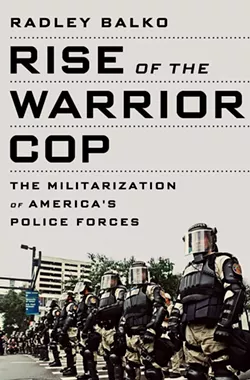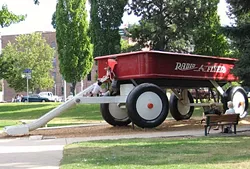Tuesday, August 18, 2015
There's still plenty of time to kick back and lose yourself in this year's selection for Spokane is Reading, the 14th annual community reading program.
This year's selection is Station Eleven, a post-apocalyptic best-seller by Emily St. John Mandel. The highly acclaimed, award-winning book is Mandel's fourth, and was nominated for the National Book Award and the PEN/Faulkner Award; it also won the 2015 Arthur C. Clarke Award. Station Eleven was named one of the 10 best books of 2014 by the Huffington Post and the Washington Post, and a screen adaptation is reportedly in the works.
Station Eleven is a dystopian tale set in the near future, after a pandemic flu kills off most of the world's population. It follows a traveling band of Shakespearian actors and examines the types of relationships that sustain us and the nature of fame. Here's more on the book (which we've just placed an order for) from its jacket:
“An audacious, darkly glittering novel about art, fame, and ambition set in the eerie days of civilization’s collapse, from the author of three highly-acclaimed previous novels.
One snowy night a famous Hollywood actor slumps over and dies onstage during a production of King Lear. Hours later, the world as we know it begins to dissolve. Moving back and forth in time—from the actor’s early days as a film star to fifteen years in the future, when a theater troupe known as The Travelling Symphony roams the wasteland of what remains—this suspenseful, elegiac, spellbinding novel charts the strange twists of fate that connect five people: the actor, the man who tried to save him, the actor’s first wife, his oldest friend, and a young actress with the Traveling Symphony, caught in the crosshairs of a dangerous self-proclaimed prophet. Sometimes terrifying, sometimes tender, Station Eleven tells a story about the relationships that sustain us, the ephemeral nature of fame, and the beauty of the world as we know it.”
Mandel is set to give two presentations in Spokane is Reading's tradition of bringing the authors it features to Spokane — one at CenterPlace Event Center in Spokane Valley at 1 pm, and a later presentation at the Bing Crosby Theater, at 7 pm, both on Thursday, October 29. Both events are free. Auntie's Bookstore will be on hand selling copies of the novel, and the author will meet fans and sign copies of her work following each talk.
A joint effort by the Spokane County Library District, Spokane Public Library and Auntie's Bookstore, Spokane is Reading began back in 2001 as a community-wide effort to encourage local adults to read and make connections through literature. Last year's book selection was Karen Russell's fantastical Swamplandia! and 2013's event highlighted Seattle author Maria Semple's Where'd You Go Bernadette.
Tags: Spokane is Reading , Station Eleven , Emily St. John Mandel , literature , Fall Arts , Arts & Culture , Image
A minister of a local African American church was recently acquitted of two counts of malicious harassment, also known in Washington state as hate crimes.
Derrick Moore, 51, argued he was acting in self defense when he threw his son, Antonio Moore, and his son's former boyfriend out of his home after he caught them having sex in his shower at 2:30 am.
Now the state will be responsible for paying the minister's legal bills and wages lost from the days of work he missed according to a law that allows defendants to get paid if a jury finds the they acted in self-defense.
The incident in question occurred February 6 after Antonio Moore and his boyfriend went out for a night of drinking. When the two men snuck into Derrick Moore's house, he was sleeping, but his wife was awake. She was helping youths from the congregation prepare for a community event the following day.
Antonio Moore, 21, has a history of drug addiction and other crimes and was banned from the home before February 6 when his 11-year-old brother found a bag of his syringes, his father says. Antonio Moore was allowed to stay there, his father told him, as long as "what he did on the street didn't come into the house." The syringes were the last straw.
John Ahern, a former Republican state representative, said that Spokane City Council President Ben Stuckart has stated that he intends to implement a $15-an-hour minimum wage on the city, not unlike the one being implemented in Seattle.
“Spokane already has an unfriendly business environment and is losing business growth,” said Ahern, who is challenging Stuckart for reelection.
So does Stuckart, or anyone else on the council, have plans in the works for a $15 minimum wage?
“No one is working on it,” says Stuckart. “And I don’t think the $15 minimum wage is appropriate. I believe honestly that $15 is too high for Spokane.”
Last week, Adam McDaniel, Stuckart’s assistant, sent out an email to the six other members of the council and its policy advisor inquiring if they were working on a $15 minimum wage ordinance. He forwarded the Inlander his responses.
“I think Karen’s head would explode if someone’s working on it,” replied Skyler Oberst, legislative assistant to Councilwoman Karen Stratton. “We’ve been fielding calls about this a lot :/”
“To date, no council member or legislative assistant of any council member has asked me to research or draft any kind of minimum wage proposal,” replied Brian McClatchey, the council’s policy advisor.
“Haven’t even looked into it at this point,” wrote Blaine Stum, legislative assistant to Councilman Jon Snyder.
“Ah, no,” replied Councilman Mike Allen.
Legislative assistants for Councilwomen Candace Mumm and Amber Waldref also denied working on it.
The only person who didn’t respond is Councilman Mike Fagan, the council’s arch-conservative. Is he secretly working on a $15 minimum wage ordinance? Is he secretly forming an alliance with Kshama Sawant, Seattle's socialist member of that city's council, who championed the city's $15 minimum wage law? The Inlander decided to investigate after the council meeting wrapped up.
“What the hell would I be doing with a $15 minimum wage?” scoffed Fagan when asked if he was working on the issue.
Tags: John Ahern , Ben Stuckart , Adam McDaniel , Karen Stratton , Skyler Oberst , Blaine Stum , Jon Snyder , Mike Allen , Candace Mumm , Amber Waldref , Mike Fagan , News , Image
With Washington facing a historic drought, the city of Spokane is asking residents to cut back on their use of water. The city gets its water from the Spokane Valley-Rathdrum Prairie aquifer, and during the heatwave in June it was pumped at record level. The Spokane River relies on water flowing from the aquifer. And because of low snow packs and all this pumping, it’s reached historic lows.
“We [water consumers] believe that it’s inexhaustible,” says John Osborn, a local conservationist who recently launched the H2KNOW campaign that’s also partnered with the city to encourage residents to be more thoughtful in their water use. “People beleive that there is no limit to the amount of water and we have a water rate structure that encourages waste, so is it any surprise that we continue to use more and more water?”
The typical Spokanite uses 20 cubic units of water annually, with every unit being the equivalent to 748 gallons of water, according to city spokesperson Marlene Feist, which pencils out to about 15,000 gallons of water.
The Inlander decided to look into who are the heaviest residential and institutional users of water in Spokane. The names of residential users are shielded from disclosure under the state’s public records, but the top residential user guzzled 3,110 cubic units of water, or 2,326,280 gallons of water.
Institutions are even thirstier, needing water for lawns, landscaping, employees, patients, saunas and more.
“Each of these institutions needs to take action to review and reduce its water use, and recognize that they have a civic leadership duty in doing so,” says Osborn.
1. The City of Spokane
Water use from July 2014 through July 2015: 129,112,280 gallons
Spokane’s municipal government is asking residents to “Slow the Flow” by not watering lawns during heat of the day, not running the hose needlessly and even undergoing an irrigation audit. Spokane’s municipal government is also its own largest consumer of water. City Spokesperson Feist says the city has multiple water-use accounts. But the one that topped all others was for the city’s wastewater treatment plant, which treats and returns cleaned water to the Spokane River. Cleaning that water, says Feist, requires water.
“It’s just part of the process of managing the wastewater,” she says. “You have to thin it down.”
2. Gonzaga University
Water use from July 2014 through July 2015: 125,970,680 gallons
“We are like a small city,” says Mary Joan Hahn, spokesperson for the university, of the housing, dining and athletic facilities all contained within Spokane’s largest institution of higher education. “So there is just a lot of need for water.”
Hahn says that 2,800 students live on campus in nearly a million square feet of residential facilities. Gonzaga works hard to conserve water, she says, using low-flow sinks and toilets as well as a computer system to manage irrigation. “We’re working hard on decreasing our use of water,” she says. “But we have a big operation.”
Tags: city of Spokane , Marlene Feist , Spokane Falls Community College , Geiger Heights Invest LLC , San Souci West , Esmeralda Golf Course , Monique Cotton , Spokane Parks and Recreation Department , UTC Aerospace Systems , UTC Aerospace Systems , Providence Health , News , Image
HERE
A mother and daughter are dead after a RV fire in Chattaroy. (KHQ)
For weeks Airway Heights has been calling for its mayor Patrick Rushing to step aside and Monday morning, he did. (KXLY)
Former Shoshone County deputy and school resource officer Shawn Alan Clark was sentenced to 20 years in prison for sexual battery that spanned 12 years. (CdA Press)
The Chelan fire has now surpassed 100,000 acres. (Spokesman-Review)
THERE
Army Ranger School graduates its first-ever female soldiers later this week. (Washington Post)
A South Snohomish Little League softball team is accused of throwing the World Series. (Seattle Times)
Tags: Morning Briefing , fire , softball , news , Image
Monday, August 17, 2015
Canadian music legend Neil Young continues to rock in the free world, coming to Spokane Arena Oct. 2. Accompanying Young, as part of the Rebel Content Tour, is Lukas Nelson (son of Willie) and his band the Promise of the Real, who played last year’s Gleason Fest.
Young has had a lot of fun this year. He duetted with Jimmy Fallon (who does a damn near perfect impression of him) and taught acting genius Meryl Streep how to play guitar for her role in Ricki and the Flash. But he’s still his old, hippie self. His current album, The Monsanto Years, made with Lukas Nelson and the Promise of the Real after meeting at a concert last year, is about exactly what you think it is — his lyrics are critical of American companies like Monsanto, Starbucks, Walmart and Chevron.
Fear not, the whole concert won’t be all new material. Young plans to dip into his decades-long catalogue for a show full of acoustic and hard rock tunes. Favorites like "Heart of Gold" and "Unknown Legend" are certain to be there. Tickets go on sale Aug. 21 and are $60 to $125.
Young was last in Spokane in 2007, playing at the INB Performing Arts Center. His sometimes bandmate Graham Nash was just in town last month.
Tags: Spokane Arena , Neil Young , Lukas Nelson and the Promise of the Real , folk rock , Music , Image , Video
When you want to talk about police militarization, you talk to Radley Balko. Formerly with the libertarian magazine Reason and the Huffington Post, Balko now blogs about criminal justice at the Washington Post. Before Ferguson thrust police-militarization issues into the national spotlight, Balko published Rise of the Warrior Cop, a book detailing police history in the United States, revealing the use of heavy weaponry, riot gear, armored vehicles like the MRAP and SWAT raids.
Spokane County, like many sheriff’s departments, has obtained a number of military vehicles, weapons and equipment through its “1033” and “1122” programs: Three helicopters, 61 M-16s, two ATVs, 11 AR-15 reflex sights, 10 infrared laser illuminators, pilot helmets, bench seats, night-vision goggles, an FLIR infrared device, seven M-14s (being sent back), a Humvee, an MRAP and 2 APCs. The department has also separately purchased an armored “Bearcat” vehicle.
Spokane County Sheriff Ozzie Knezovich is a military veteran himself, having served in the United States Army for three years. He was a training officer for the SWAT team. And in a presentation back in June, he called police militarization a "myth" — a central part of this week’s cover story.
Knezovich suggests that the region's history of homegrown-terror attacks justify such heavy-duty weapons and equipment.
Last Monday, before our cover story was out, I got a chance to interview Balko, and asked him to address a few of Knezovich’s arguments:
On whether the police have always been militarized
“If the standard for the militarization of police is the use of military weapons and equipment, how long has this so-called militarization been going on?” one slide in Knezovich’s presentation asks.
Knezovich goes on to cite the Winchester Repeating Rifle and the Colt Peacemaker. “I wonder how many people would be telling Wyatt Earp to send his Peacemaker back,” Knezovich says.
He also cites the Thompson Submachine Gun and the Browning Automatic Rifle, used in the 1920s. “Yeah, the Mafia used 'em too,” Knezovich says.
But the way that cops were armed was a bad thing during Prohibition, Balko argues. “That was a problem at the time, not something to recall fondly,” Balko says. (He sees a parallel between Prohibition in the 1920s and the drug war today. Both caused police to be more militarized)
As for the implication that little has changed, Balko’s book provides plenty of stats showing that, statistically, there’s been a dramatic rise in both SWAT raids and SWAT teams in small towns, despite the precipitous plunge in crime since 1995.
Percentage of towns between 25,000 and 50,000 people with a SWAT team in 1984: 25.6 percent . . . in 1990: 52.1 percent
…in 2005: 80 percent
Approximate number of SWAT raids in the United States in 1995: 30,000
. . . in 2001: 45,000
. . . in 2005: 50,000– 60,000
On SWAT raid failure rates
Many of the most horrifying stories from Balko’s book center on raids that go wrong. A SWAT team will come full force, knock down a door, throw in a flashbang, only to find that they’re at the wrong address. In one infamous case they killed the dog of the town’s mayor, after raiding his address incorrectly.
Balko's 2006 white paper at the CATO institute summarized it this way:
“The use of hyper-militarized, heavily armed police units to carry out routine search warrants has become increasingly common since the 1980s. These raids leave a very small margin for error. A wrong address, bad timing, or bad information can—and frequently does— bring tragedy.”
It’s the information from this paper that makes its way to Knezovich’s presentation.
“These are all botched SWAT raids,” Knezovich says, pulling up a slide of the CATO Institute’s map of botched raids, noting the information went all the way back to 1985. “It took 30 years to put all those dots on those map. I would challenge any business to have a failure rate as good as this, over 30 years.”
But Balko says Knezovich misunderstands the map. It was an attempt to show the breadth of botched raids, including this 2010 incident where the Washington State Patrol shot a pregnant woman during a drug raid in Spokane. But it was in no way an attempt to be comprehensive, or even to be an account of every recorded raid that went wrong. And many times, raids that go wrong aren’t reported. The victims of such raids can often be low-income people, already suspicious of law enforcement and media outlets.
“The vast, vast majority of the people these botched raids happen to don’t report it,” Balko says. “I don’t think we have any sort of grasp on how often that happens.”
On the use of armored vehicles
In his presentation, Knezovich details local 30 years of white supremacist groups using bombs and booby traps to justify the department's use of its MRAP.
While Balko agrees with Knezovich that there may be circumstances where the use of an armored vehicle would be warranted in a mid-to-large-sized city, he objects to how many of the military’s MRAPs have gone to small towns.
“We’re talking towns of 1,500 to 2,000 people,” Balko says. There are places like Post Falls (population 30,000.) The tiny Clearwater County, east of Moscow, Idaho, requested an MRAP “for “drug and marijuana eradication.”
The problem with such military equipment, he says, is that their presence and high maintenance costs creates a pressure to use them often. (Mother Jones outlines that some police forces have used their military-grade armored vehicles to police football games and to raid a no-kill animal shelter illegal raising a baby deer named Giggles.)
On whether true militarization happens if police don’t have or use the equipment they need
“You talk militarization, there it is. Baltimore,” Knezovich says, as he flicks through pictures of National Guard troops in Baltimore and Ferguson. “That’s militarization folks. Those are weaponized. That is a turret… ”
He blames the Baltimore National Guard presence, in part, for the Baltimore’s police officers not being allowed to wear their riot gear. Indeed, an after-action review confirms that the officers weren’t allowed to wear full-riot gear.
But there were many objections to the police response in Baltimore, including the gear the cops did use initially. This report also revealed that “officers were ordered to allow the protesters room to destroy and allow the destruction of property so that the rioters would appear to be the aggressors,” and that “the Baltimore Police Department would not respond until they [the protesters] burned, looted, and destroyed the city so that it would show that the rioters were forcing [its] hand.”
And in Ferguson, the riot gear and heavy equipment came long before any violence. In many cases, Balko says, militarized police equipment becomes a self-fulfilling prophecy.
“When police show up in the full riot gear, it tends to escalate tensions,” Balko says. “When you come expecting violence, you get violence."
In many cases, Balko argues that the police, especially those in small towns, don’t need some of the equipment they have. Non-military style equipment, like a bulletproof SUV, can function just as well as an MRAP in most situations, he suggests.
But more than the military style gear itself, Balko worries about the mindset it brings. Military-style weapons tend to foster a military style personality, he says.
“I think the problem is the training is moving the exact opposite direction it needs to be moving,” Balko says.
On blaming rhetoric for violence
But Knezovich’s central thesis, beyond simply a defense of police militarization, is to cast blame on some groups of anti-government critics, especially ones who lie or spread false conspiracy theories, for future incidents of violence. The critique is a familiar one: In the days after the Oklahoma City bombing, Bill Clinton cast blame on "the purveyors of hatred and division."
Balko condemns that genre of argument:
I think it’s ridiculous. I think criticizing the government is a pretty cherished and protected [freedom]. If somebody misinterpreted your criticism and it meant an unstable person does something violent, I don’t think the person making tepid non-violent criticism is responsible.
Environmentalists aren’t to blame for the Unabomber. Peaceful pro-life activists aren’t responsible for abortion clinic bombings. It’s a cheap way of shunting your critics to the fringes and lumping them in with violent people.
Tags: Ozzie Knezovich , Radley Balko , Spokane County , MRAP , police militarization , News , Image , Video
They would be Gentlemen of the Road. They would tour around the world, from the U.K. to North America to Australia, and visit small towns with no arenas. They’d access the entire community to celebrate its history, culture and especially, its beer. Plus, they’d bring some of their most talented friends. They've done that 15 times (to great success) since 2012.
Over the weekend (August 14-15), it was Walla Walla’s turn to host Gentlemen of the Road. The 2015 stopovers were already going to be special, featuring nine other great musicians including tUnE-yArDs, the Flaming Lips, Dawes and the Vaccines, but Walla Walla was uniquely visited by another set of Washingtonian gentlemen: Foo Fighters.
On the windy, dusty and hot weekend in Walla Walla, we slept in a tent, laughed as out-of-staters giggled at the slogan “A town so nice, they named it twice!” and enjoyed a truly excellent festival.
Here’s what we saw, heard and thought through two days of live music in the heart of Washington’s wine country.
Tags: festival , mumford & sons , folk , rock , review , Music , Gentlemen of the Road , Image
For those of you without enough time in your day to peruse our event listings and Staff Picks for something fun to do this week, we're here to help. Here are some of the highlights from the week ahead:
Monday, Aug. 17
LIVE BANDS | Who doesn't love a free show? Not anyone with any sense. Baby Bar has one for you Monday night, courtesy of touring Oakland bands Daisy World and Healers, along with Mirror Mirror.
ETC | I know more than a few of you are Pokemon fans. Get our your cards and put your skills to the test at a Pokemon Tournament starting at 6 pm at the North Spokane Library. Open to all ages.
Tuesday, Aug. 18
FILM | The hits keep on coming at the Garland Theater's Summer Camp film series. This week, it's Danny and Sandy and the rest of the Pink Ladies in the musical Grease. You know you love it.
COMMUNITY | Celebrate the 25th anniversary of what we all know as "the little red wagon" in Riverfront Park, and meet the artist who made it.
Tags: What's Up? , Image , Video

If you've ever been to Spokane, you've probably seen the world's largest Radio Flyer wagon. It's in Riverfront Park and it's really quite large – 12 feet tall and wide and 27 feet long. The big, red wagon, officially named "The Childhood Express," is nearing it's 25th birthday in January.
Ken Spiering is the artist behind this iconic Spokane monument, and in an Inlander exclusive, he shared three previously unreleased 1990 slides depicting its construction.
“I’m really happy with how well it’s held up and how loved it is. I don’t think you get much perspective on that in the first decade, but after this length of time," Spiering says, regarding the 25th anniversary, "I’m just thrilled with the way this city has received it. How can one not feel tremendous for being a part of making it?”
Tags: ken spiering , art , red wagon , childhood express , junior league , Arts & Culture , Image








